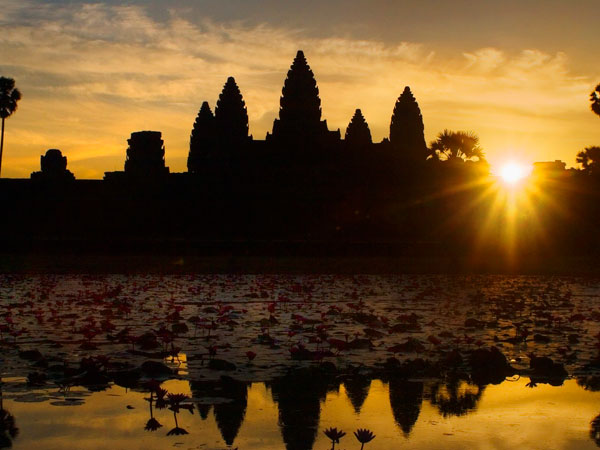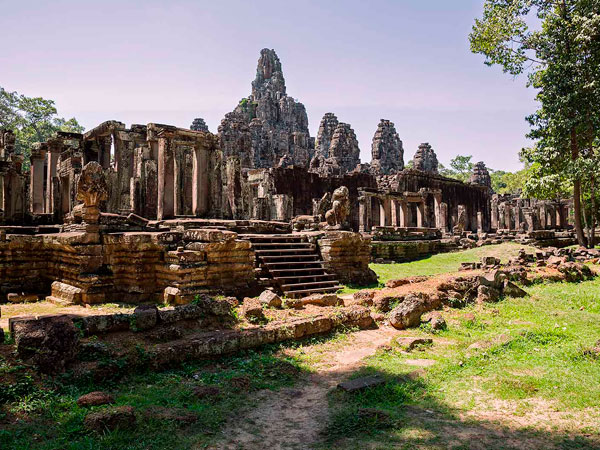Location: Outside main park area, approx. 38 km north of Siem Reap
Getting there: Drivers charge an extra fee for the trip.
Construction period: Late 10th century C.E.
Religion: Hindu
Built by: King Rajendravarman, later under King Jayavarman V.
Building style: Banteay Srei
Photography: Many of the carvings are cordoned off, and a long lens and tripod are needed for carving close-up shots. The colors of the temple are at their best before 10:00, and after 14:00.
The name Banteay Srei (sometimes written as 'Banteay Srey') translates from Khmer roughly as the ‘citadel of the women,’ but this is a recent name that most likely was applied because of the pink sandstone and the delicate carvings. This beautiful 10th century temple is dedicated to the Hindu god, Shiva. It has some of the most exquisite carvings of any Khmer temple, and has almost a storybook ambiance. The detailed carving of the sculptures, lintels, and friezes, make it an aesthetically pleasing structure. The walls are covered with deep, intricate carvings, each one carved with superb detail.
Banteay Srei was built by a Brahmin counselor to King Rajendravarman, and was built at a time when the Khmer Empire was growing in power and territory. A visit to Banteay Srei can be combined with a visit to Banteay Samre. The temple area closes at 17:00.
Background of Banteay Srei
The enchanting temple of Banteay Srei is nearly everyone’s favorite site. The special charm of this temple lies in its remarkable state of preservation, small size and excellence of decoration.
The unanimous opinion amongst French archaeologists who worked at Angkor is that Banteay Srei is a ‘precious gem’ and a ‘jewel in Khmer art’. Banteay Srei, as it is known by locals, was originally called Isvarapura, according to inscriptions. It was by a Brahmin of royal descent who was spiritual teacher to Jayavarman V. Some describe it a s being closer in architecture and decoration to Indian models than any other temple at Angkor. A special feature of the exquisite decoration was the use of a hard pink sandstone (quartz arenite) where enabled the ‘technique of sandalwood carving with even an Indian scent to it’.
- Location: 25 kilometers (15.5 miles) north-east of East Mebon
- Access: enter and leave the temple by the east entrance
- Date: second half of the 10th century (967)
- King: Rajendravarman II (reigned 944-968) and Jayavarman V (reigned 968-1001)
- Religion: Hindu (dedicated to Shiva)
- Art style: Banteay Srei
Materials and style
Banteay Srei is built largely of a hard red sandstone that can be carved like wood. Brick and laterite were used only for the enclosure walls and some structural elements. The temple is known for the beauty of its sandstone lintels and pediments.
A pediment is the roughly triangular space above a rectangular doorway or openings. At Banteay Srei, pediments are relatively large in comparison to the openings below, and take a sweeping gabled shape. For the first time in the history of Khmer architecture, whole scenes of mythological subject-matter are depicted on the pediments.
A lintel is a horizontal beam spanning the gap between two posts. Some lintels serve a structural purpose, serving to support the weight of the superstructure, while others are purely decorative in purpose. The lintels at Banteay Srei are beautifully carved, rivalling those of the 9th century Preah Ko style in quality.
Many niches in the temple walls contain carvings of devatas or dvarapalas.
Noteworthy decorative motifs include the kala (a toothy monster symbolic of time), the guardian dvarapala (an armed protector of the temple) and devata (demi-goddess), the false door, and the colonette.[16] Indeed, decorative carvings seem to cover almost every available surface. According to pioneering Angkor scholar Maurice Glaize, “Given the very particular charm of Banteay Srei — its remarkable state of preservation and the excellence of a near perfect ornamental technique — one should not hesitate, of all the monuments of the Angkor group, to give it the highest priority.” At Banteay Srei, wrote Glaize, “the work relates more closely to the art of the goldsmith or to carving in wood than to sculpture in stone”









